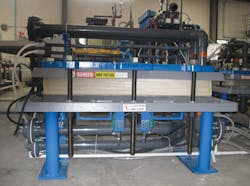The Electrodialysis Advantage
Electrodialysis was developed in the mid-1950s to demineralize brackish water at commercial scale. In general, electrodialysis and electrodialysis reversal are considered more appropriate for applications in processes with low total dissolved solids (TDS). Both processes have a good degree of resistance against scaling and fouling, which makes the technology attractive in brackish water desalination.
Electrodialysis has been applied in fields such as brackish and seawater desalination; salt production by concentrating seawater or using brine discharged from a reverse osmosis (RO) seawater desalination plant; recovering RO concentrate stream; and citric acid separation.
Drinking water supplies in the southwestern U.S. are highly dependent on groundwater sources. Due to an emerging water crisis, brackish groundwater continues to be considered a resource for drinking water supplies. Depending on the location of the available brackish resource, however, there are different water chemistries to contend with and concentrate issues to address. Electrodialysis may be an appropriate desalination technology to utilize in these applications.
How Electrodialysis Works
Electrodialysis is a membrane separation process in which ions are transported through semipermeable membranes under the influence of an electric field from one solution to another in order to reduce the ionic content of water. The electrodialysis stack is composed of alternately constructed cation and anion exchange membranes to form dilute and concentrate chambers.
Additionally, the two ends of the stack are blocked with two electrodes that are in contact with electrode rinse solutions. By applying a determined amount of voltage, the two end electrodes generate the potential field required for anions to be transported toward the anode and the cations to be transported toward the cathode. During electrodialysis, the cation exchange membranes permeate cations and block anions, while the anion exchange membranes do the opposite. Two different solutions therefore are generated in this process: one dilute and the other concentrate.
In electrodialysis reversal, the electrodialysis process is enhanced by periodically changing the direction of ion transport. This periodic change in polarity is done in order to prevent scaling and fouling problems and increase process efficiency.
Ion Removal & Selectivity
During the electrodialysis process, various ions are removed at different rates, depending on the operating conditions inside the stack, their specific charges and the selectivity of the membranes in the stack. Rates also depend on the mobility of the ions in the solution, which is affected by their hydrated radii in solution. Ions with a smaller hydrated radius have higher mobility, while ions with greater charge (divalent or greater) are affected by the electrical field more than monovalent ions.
Another factor is the permeability of counter ions in a membrane that is influenced by the ion exchange selectivity, as well as the mobility and selectivity in the membrane phase. The mobility of different ions in the membrane is determined by the steric effects, the size of ions and the cross-linking density of the membrane. Furthermore, the ion exchange selectivity is determined mostly by electrostatic interactions.
The impact of ion mobility and permeability differs under various operating conditions. At low applied voltage, the membrane plays an important role in selectivity of a type of ion, but that diminishes at higher voltage where the membrane does not play a significant role in the preferential transport of selective ions. The range and effect of operating conditions (as well as membrane type) on selectivity of ions is determined experimentally and is impacted by water chemistry. The membrane type and concentration of a certain ion has an impact on the selectivity coefficient for the transport of divalent ions such as calcium ions.
Selective removal of sodium or calcium ions is feasible here, given the appropriate concentration ratio of the ion of interest using membranes that are modified by the compound epichlorohydrin. Monovalent ions and multivalent ions are removed selectively according to operating conditions and ion exchange membrane types.
A combination of the membrane types, operating conditions and water chemistry affects the preferential removal of ionic species in the electrodialysis process. Depending on the specifics of the operating conditions such as pH, feed concentration, applied voltage, temperature and flow rate, selectivity in the various membrane types is impacted. As a result, under selective experimental conditions, the removal of monovalent ions is greater than divalent and trivalent ions.
Selectivity also is driven by the specifics of counter ions, typically based on the following:
- Electroselectivity: Defined by the Donnan Potential, this is the effect of counter ion valences on ion exchange equilibrium. The strength of the Donnan Potential is proportional to the ionic charge. Highly charged ions have a stronger potential for exchange.
- Ionic hydration and swelling pressure: Larger hydrated counter ions cause stronger swelling and greater swelling pressure. The ion exchange membrane thus prefers counter ions with smaller hydrated ions due to the elasticity of its membrane.
- Sieve action: In contrast to the swelling pressure factor, the small counter ions cannot be replaced completely by large ions due to sieve action.
- Ion interaction: Specific interactions among the ions in the exchange membrane, as well as association and complex formation by them in the solution, also affect selectivity.
Temperature and pressure also are important factors in selectivity, specifically when organic and other special components are present and can interact with the counter ions. Depending on the water chemistry, the selectivity could be adversely impacted by ions that interfere with the removal of the ions of interest. Because the cost of the electrodialysis process is proportional to the amount of ions removed, selective removal of targeted ions can significantly help reduce process costs.
Further Research of Electrodialysis Required
In advanced water treatment approaches, electrodialysis provides clear advantages over other technologies when used in brackish water desalination with low TDS. Still, due to the interactions associated with various water chemistries, operating conditions and membrane types, the selective removal of ions continues to require research and must be application specific.
Download: Here
